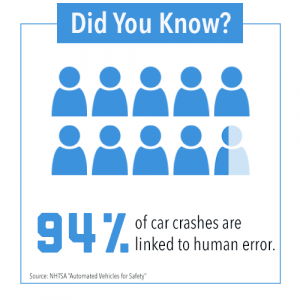Written By: Jubin Arora, GMBA Class of 2019, Crystal Martinson MBA Class of 2018, Michael Steinberg MPP Class of 2018, Aditya Sharma MBA Class of 2018
The elderly and disabled communities often face significant mobility challenges when undertaking everyday tasks and running simple errands. Often, it is difficult for these individuals to get to work, visit the doctor, and attend social activities. Thankfully help is on the way. In the very near future autonomous vehicles could provide a way for these individuals to become mobile, independent, and play an even more active role in the workforce and society.
 According to the American Automobile Association, by 2030, there will be 70 million Americans older than 65 with driver’s licenses—a sharp increase from the 40 million registered in 2015. The increase in the number of elderly drivers on the road, due to the aging Baby Boomer generation, will present increasing challenges. Many elderly individuals live in suburbs or rural areas with limited or costly transportation options, which further compounds their mobility issues1. Accidents and declining health will likely cause these elderly individuals to lose their licenses and thus their independence2; however, mobility is essential for continued participation in social and community activities, which provide necessary human interactions that boost health and well-being3. Those with vehicle access better utilize health and regular care options4. The availability of autonomous vehicles will be critical to improve safety while driving, transportation options, and quality of life with our aging population.
According to the American Automobile Association, by 2030, there will be 70 million Americans older than 65 with driver’s licenses—a sharp increase from the 40 million registered in 2015. The increase in the number of elderly drivers on the road, due to the aging Baby Boomer generation, will present increasing challenges. Many elderly individuals live in suburbs or rural areas with limited or costly transportation options, which further compounds their mobility issues1. Accidents and declining health will likely cause these elderly individuals to lose their licenses and thus their independence2; however, mobility is essential for continued participation in social and community activities, which provide necessary human interactions that boost health and well-being3. Those with vehicle access better utilize health and regular care options4. The availability of autonomous vehicles will be critical to improve safety while driving, transportation options, and quality of life with our aging population.
Autonomous vehicles will also expand mobility options for the more than 47 million Americans5 with disabilities, particularly the 6 million people who have difficulty accessing transportation. Although there are a wide range of disabilities that impact a person’s ability to drive, such as blindness, physical limitations, or deafness, highly or fully automated self-driving cars will allow most anyone to drive safely and independently. Paratransit, the tax payer-provided transportation services for disabled persons, can cost up to four times as much as mass transit options6 — where mass transit is even available. While there are distinct differences between the elderly population and the disabled community, both groups lack freedom and independence when they lack mobility.
When auto manufacturers, technology companies, and policymakers develop and evolve vehicles, software, and regulations, they must all accommodate the needs and concerns of the elderly and disabled communities. Empowering these large groups, by improving their mobility and allowing them to better integrate into the workforce and the community will benefit not just these populations, but society as a whole.
This blog is part of a series created under the direction of Bonnie Pierce, Lecturer in Strategic Management and Public Policy, for the GW Business School class “Business and Society: Autonomous Vehicles.”
1Rosenbloom S., “Transportation needs of the elderly population.” Clin Geriatr Med. 1993 May; 9(2): 297-310.
2Lawrence, Eric. “When Should Elderly People Stop Driving,” January 20, 2014.
3Dickerson AE, Molnar LJ, Eby DW, Adler G, Bédard M, Berg-Weger M, Classen S, Foley D, Horowitz A, Kerschner H, Page O, Silverstein NM, Staplin L, Trujillo L. “Transportation and aging: a research agenda for advancing safe mobility,” Gerontologist. 2007 Oct; 47(5):578-90.
4Syed, S. T., Gerber, B. S., & Sharp, L. K. (2013). Traveling Towards Disease: Transportation Barriers to Health Care Access. Journal of Community Health, 38(5), 976–993.
5Auto Alliance, “Conference on Autonomous Vehicles and the Disability Community,” October 27, 2017.



